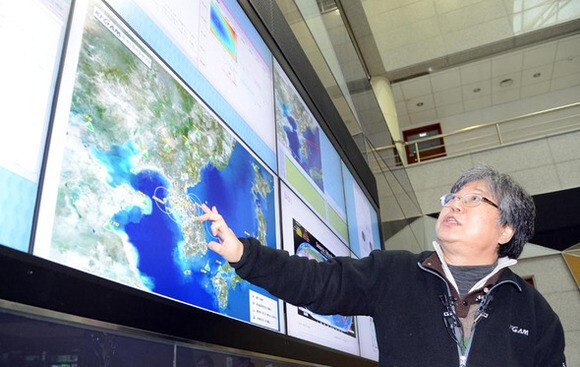hankyoreh
Links to other country sites 다른 나라 사이트 링크
Post-nuke test detection efforts turn up no radiation thus far

By Lee Keun-yong, science correspondent
The Nuclear Safety and Security Commission (NSSC) said that as of 3pm on Feb. 14, two days of detection efforts had failed to find any radioactive isotopes following North Korea's Feb. 12 nuclear test. The samples were taken from the area near the DMZ and the East Sea.
The NSSC conducts detection efforts to determine whether a nuclear test has taken place, as various radioactive isotopes that cannot normally be found in nature are produced when an atomic device explodes. The primary isotopes are four varieties of xenon, which have half-lives between nine hours and 12 days.
According to the NSSC, a total of six air samples were taken, five using two fixed land-based detectors and another using a mobile detector on a ship, but no xenon was found in any of them. Two samples were also gathered by a mobile airborne detector, but analysis found no particulate radionuclides such as cesium. Particulate radionuclide analysis looks for isotopes attached to yellow dust and other forms of fine dust.
An NSSC source said the chance of radioactive isotopes leaking into the atmosphere was very slim when a nuclear test is conducted underground, adding that sample collection would also be complicated by the isotopes dissipating into the air.
"We do have an outstanding xenon detector with the 'Sauna-2,' so if we can just get a sample, I think we'll be successful with the detection," the source said.
The NSSC plans to continue its detection efforts through the weekend, conducting additional analysis on second and third samples taken by aircraft that arrived on Feb. 14.
It also announced that it was using another isotope detector at the Korea Atomic Energy Research Institute to check for the presence of krypton, with results to come around the weekend.
In principle, the proportions of xenon and krypton should be able to show whether an atomic device used plutonium or highly enriched uranium. However, experts said that even if both isotopes are detected, the amounts would most likely be too small to identify the material used.
Please direct questions or comments to [english@hani.co.kr]

Editorial・opinion
![[Column] Park Geun-hye déjà vu in Yoon Suk-yeol [Column] Park Geun-hye déjà vu in Yoon Suk-yeol](https://flexible.img.hani.co.kr/flexible/normal/500/300/imgdb/original/2024/0424/651713945113788.jpg) [Column] Park Geun-hye déjà vu in Yoon Suk-yeol
[Column] Park Geun-hye déjà vu in Yoon Suk-yeol![[Editorial] New weight of N. Korea’s nuclear threats makes dialogue all the more urgent [Editorial] New weight of N. Korea’s nuclear threats makes dialogue all the more urgent](https://flexible.img.hani.co.kr/flexible/normal/500/300/imgdb/original/2024/0424/7317139454662664.jpg) [Editorial] New weight of N. Korea’s nuclear threats makes dialogue all the more urgent
[Editorial] New weight of N. Korea’s nuclear threats makes dialogue all the more urgent- [Guest essay] The real reason Korea’s new right wants to dub Rhee a founding father
- [Column] ‘Choson’: Is it time we start referring to N. Korea in its own terms?
- [Editorial] Japan’s rewriting of history with Korea has gone too far
- [Column] The president’s questionable capacity for dialogue
- [Column] Are chaebol firms just pizza pies for families to divvy up as they please?
- [Column] Has Korea, too, crossed the Rubicon on China?
- [Correspondent’s column] In Japan’s alliance with US, echoes of its past alliances with UK
- [Editorial] Does Yoon think the Korean public is wrong?
Most viewed articles
- 1‘We must say no’: Seoul defense chief on Korean, USFK involvement in hypothetical Taiwan crisis
- 2N. Korean delegation’s trip to Iran shows how Pyongyang is leveraging ties with Moscow
- 3‘Weddingflation’ breaks the bank for Korean couples-to-be
- 4Will NewJeans end up collateral damage in internal feud at K-pop juggernaut Hybe?
- 546% of cases of violence against women in Korea perpetrated by intimate partner, study finds
- 6[Column] Park Geun-hye déjà vu in Yoon Suk-yeol
- 7“Parental care contracts” increasingly common in South Korea
- 8[Column] Yoon’s first 100 days should open our eyes to pitfalls of presidential system
- 9[Interview] Dear Korean men, It’s OK to admit you’re not always strong
- 10[Editorial] New weight of N. Korea’s nuclear threats makes dialogue all the more urgent